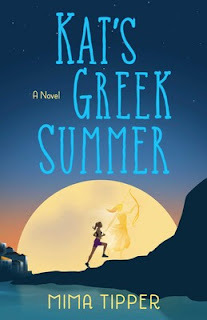Interview with Mima Tipper, Author of Kat's Greek Summer
 Welcometo Smack Dab, Mima! Tell us a bit about Kat’s Greek Summer.
Welcometo Smack Dab, Mima! Tell us a bit about Kat’s Greek Summer. Thanksso much for the kind welcome! I’ve got to tell you: I read through all of yourquestions before starting the interview, and I’m so psyched at the depth andvariety of the threads/topics you picked from the book.
And so,about the book: Kat’s Greek Summer is about a fourteen-year-old girl whorisks all for family, first love and self-truth over one sun-drenched Greeksummer.
A little more: soon to be high school freshman Kat Baker is all about training for thecross-country team this summer. Then her Greek mom knocks her off-course bydragging her to Greece. To meet the family. How can a girl train inninety-billion degrees? And with a sharp-eyed yiayiá watching her everymove? Determined to keep her running dream alive,
Iwas so excited to see a book about a girl in this age range (14). It’s sooverlooked—that strange area between MG and YA. Why did you gravitate towardwriting for this group?
I don’tthink I gravitated toward writing for this age group as much as to writingabout a young character at a pivotal time in her young life, ready to make ahuge transition. I see the move from middle to high school as just such a place.I have a lot of memories and feelings about that time in my own life, andwanted to reflect and imagine on that time for this story.
Thejourney of cultural identity is central to the novel. How much of your ownexperience influenced Kat's character and her struggle to connect with herGreek heritage?
Myoriginal plan was not to focus so much on the cultural identity struggle in thestory. I was thinking more general, as in “fish out of water.” Only as I wrote,so many memories and feelings about my own half Greek half American childhoodsurfaced, and my character Kat started asking some very pointed questions.Questions that had me digging very deeply into my own childhood struggle withmy two cultures. A lot of what I found in my memories and my feelings ended upin the novel.
Thesetting of Paralia is vividly portrayed throughout the novel. Is this fishingvillage based on a real place in Greece that you've visited? Any tips formaking a physical location so real on the page?
Paraliais based on my memories of the Greek fishing village where I spent my childhoodsummers. That village is called Alepahori, and it has changed a lot since I wasyoung so I didn’t want to use it as an actual location in the novel. I knowthere are still many villages and communities in Greece that are very rustic,and I wanted to capture that feeling for this book. The word “paralia” means“beach” in Greek, and it’s such a musical word; I figured that was a good namefor my fictional village. As far as making a physical location real on thepage, I always try to use locations in my stories of places I’ve visited,whether a town, a house, or and apple orchard. Sometimes I visit the placeagain, and take copious notes. Whether I am able to visit again, or whether Isimply have to remember, I spend a lot of time thinking of sensory feelings anddetails from those memories, and then imagine my characters experiencing thosesensory feelings and details.
Howdid you approach writing the romance between Kat and Theofilus for a youngeraudience? The relationship feels authentic and age-appropriate while stillcapturing the intensity of first love.
I adoreromance stories, always have, and wanted a romantic thread for Kat. Theofilusis very loosely based on a Greek boy I met during my 15th summer,and I had a lot of fun thinking of that time and remembering my feelings aroundthat crush, as well as crushes when even younger. I don’t know about other children’sor YA writers, but I think part of the reason I gravitate toward stories ofchildren and teens is that I have very vivid memories of my childhood and teenfeelings. I also have three children, so had a front row seat fairly recentlyto their early teen years.
Runningserves as both a literal and metaphorical journey for Kat. What inspired you tomake this activity so central to her character development?
When Ibegan to envision Kat, I wanted her to be as opposite to me at that age aspossible. With that in mind, I wanted to create a character who knows highschool is going to be a big change and a big opportunity for change, and beproactive about her desire to find a place and fit in. When my own kids werestarting high school, there was thinking and advice around choosing to be partof an athletic team because then freshmen were invited to come to the“pre-season” before school started—a good time to make friends, etc. Thatseemed exactly what would strike Kat, and cross country seemed perfect becauseat least in Vermont anyone is welcome to join as opposed to the morecompetitive teams. And from my own kids’ experience, the cross-country runnersgenerally have trainings all summer.
Theofilus'sartistic talents and dreams are really almost a complete opposite to Kat'srunning. Was there a particular reason you chose art as his passion?
As Iimagined Theofilus, I knew he had to be a relative outsider to the village, andthat he had to have compelling motivation to behave as he does through thebook. Having him be an artist was also physically possible because art is anactivity that has many portable aspects, and could be done at any time, sowould work with his fishing/boat duties. I also thought that both he and Kathaving strong and personal passions would give them a very natural connectionpoint.
Howdid you decide which cultural elements to include (food, mythology, etc.)?
Oh, my,that’s a huge question. Many of those cultural elements came through little bylittle through all of my drafting. The food is all food that my own Greek yiayiácooked for me during my own Greek summers. And I am a huge and lifelongGreek mythology fan. The original title of the book was “Greek God Summer” and backin those versions every chapter was Kat battling or experiencing somethingGreek mythology related. I’d have to go way back in my files to find one ofthose early drafts, but an example would be something like “Chapter One, Hermesbrings a message”. Those chapter headings didn’t last, but the goddess Artemisplayed into some of the headings, and I found that Kat just kept looking toArtemis, kind of like a secret friend.
Thenovel ends with Kat embracing possibilities rather than with everything neatlyresolved. The ambiguous ending is so tough to write! How did you navigate itwhile also giving the book a satisfying conclusion?
Thanksso much for saying that about my ending. As one of the themes of the book isclaiming your “self” and your heritage, it was important to me that part ofKat’s journey is to understand how getting to the “top” or the “end” ofsomething is not the actual top or end. That there’s always more. In that way,it made sense for her to reach one big goal, but that part of reaching thatgoal was to understand that there would be many, many more on her horizon.
What’snext?
I justsigned a contract for my next book which will come out in the summer of 2026,and it is a contemporary paranormal YA. I’m pretty focused on Kat’s GreekSummer right now, of course, but I’ll be posting about my next book on mywebsite and on social media soon, so stay tuned.

Where can we find you?
https://facebook.com/mimatipper
https://mimatipper.substack.com



